Some results of NAA collaborative study in white rice performed at Dalat nuclear research institute
White rice is a main food for Asian people. In the framework of Forum for Nuclear
Cooperation in Asia (FNCA), therefore, the eight Asian countries: China, Indonesia, Japan, Korea,
Malaysia, the Philippines, Thailand and Vietnam selected white rice as a common target sample for a
collaboration study since 2008. Accordingly, rice samples were purchased and prepared by following
a protocol that had been proposed for this study. The groups of elements that were analyzed by using
neutron activation analysis in the white rice samples were toxic elements and nutrient elements,
including: Al, As, Br, Ca, Cl, Co, Cr, Cs, Fe, K, Mg, Mn, Na, Rb and Zn. The analytical results were
compared between the different countries and evaluated by using the Tolerable Intake Level of World
Health Organization (WHO) and Recommended Dietary Allowance or Adequate Intake (AI) of the
U.S. Institute of Medicine (IOM) guideline values. These data will be very useful in the monitoring of
the levels of food contamination and in the evaluation of the nutritional status for people living in
Vietnam and other Asian countries.
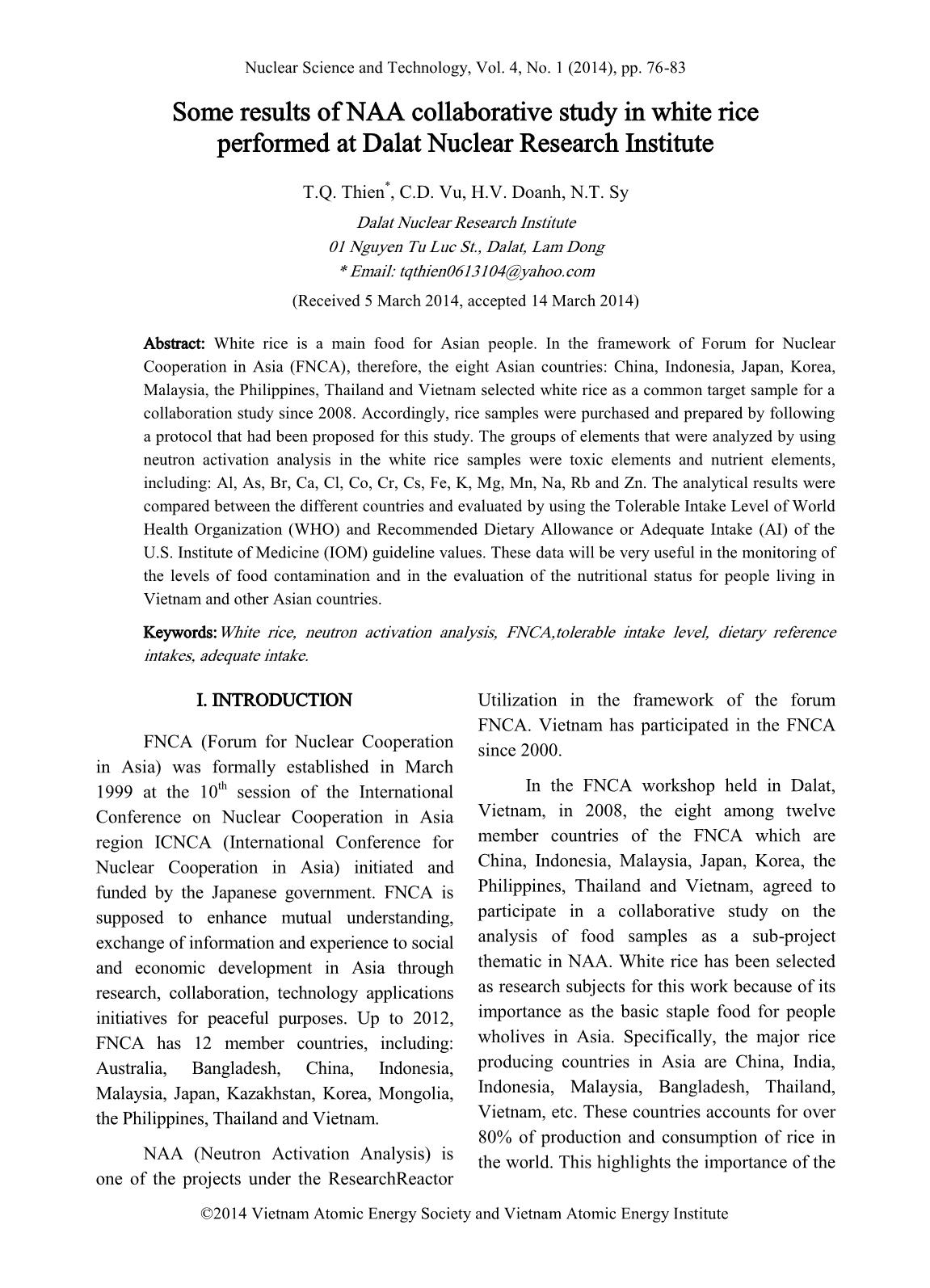
Trang 1
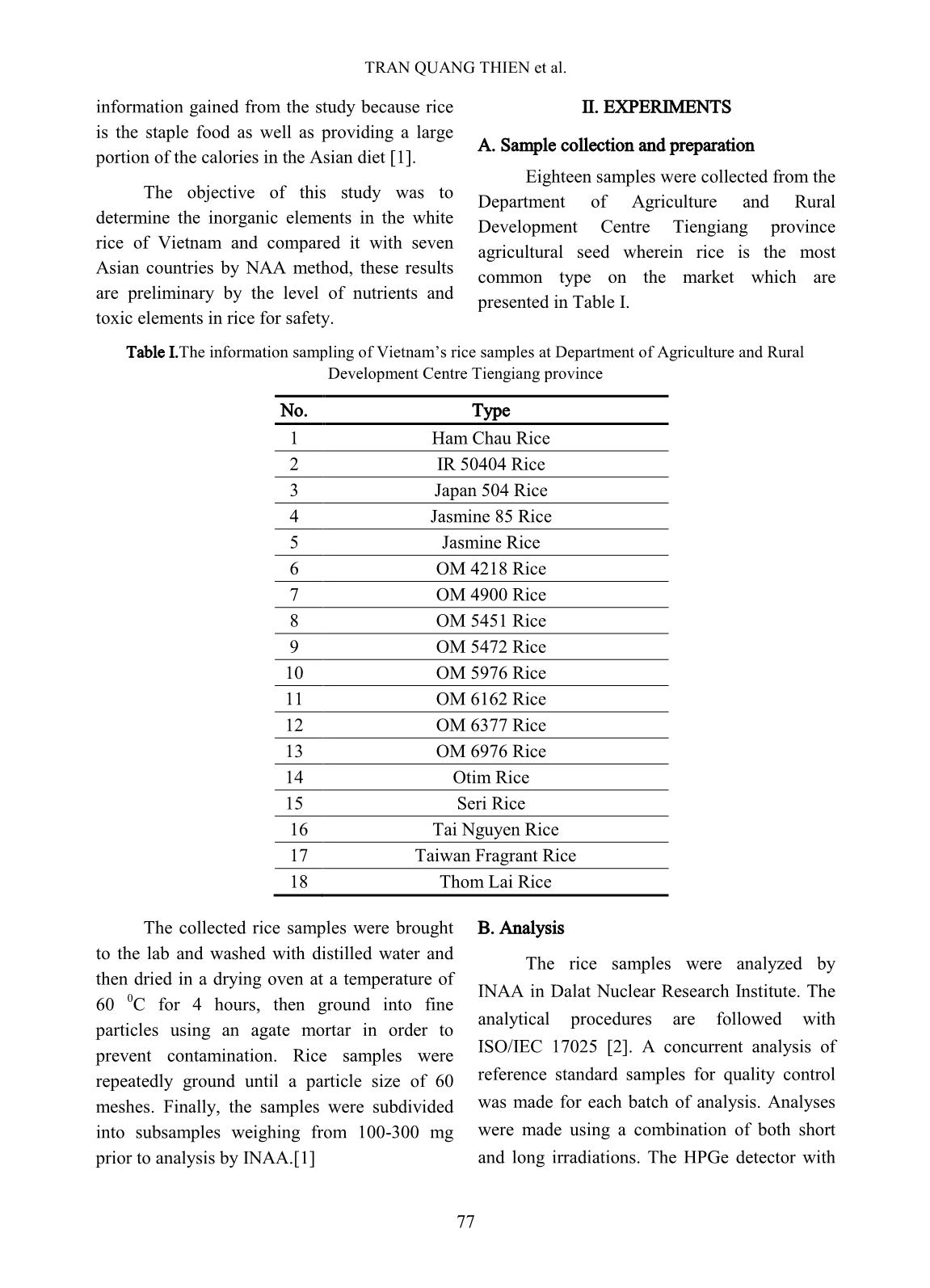
Trang 2
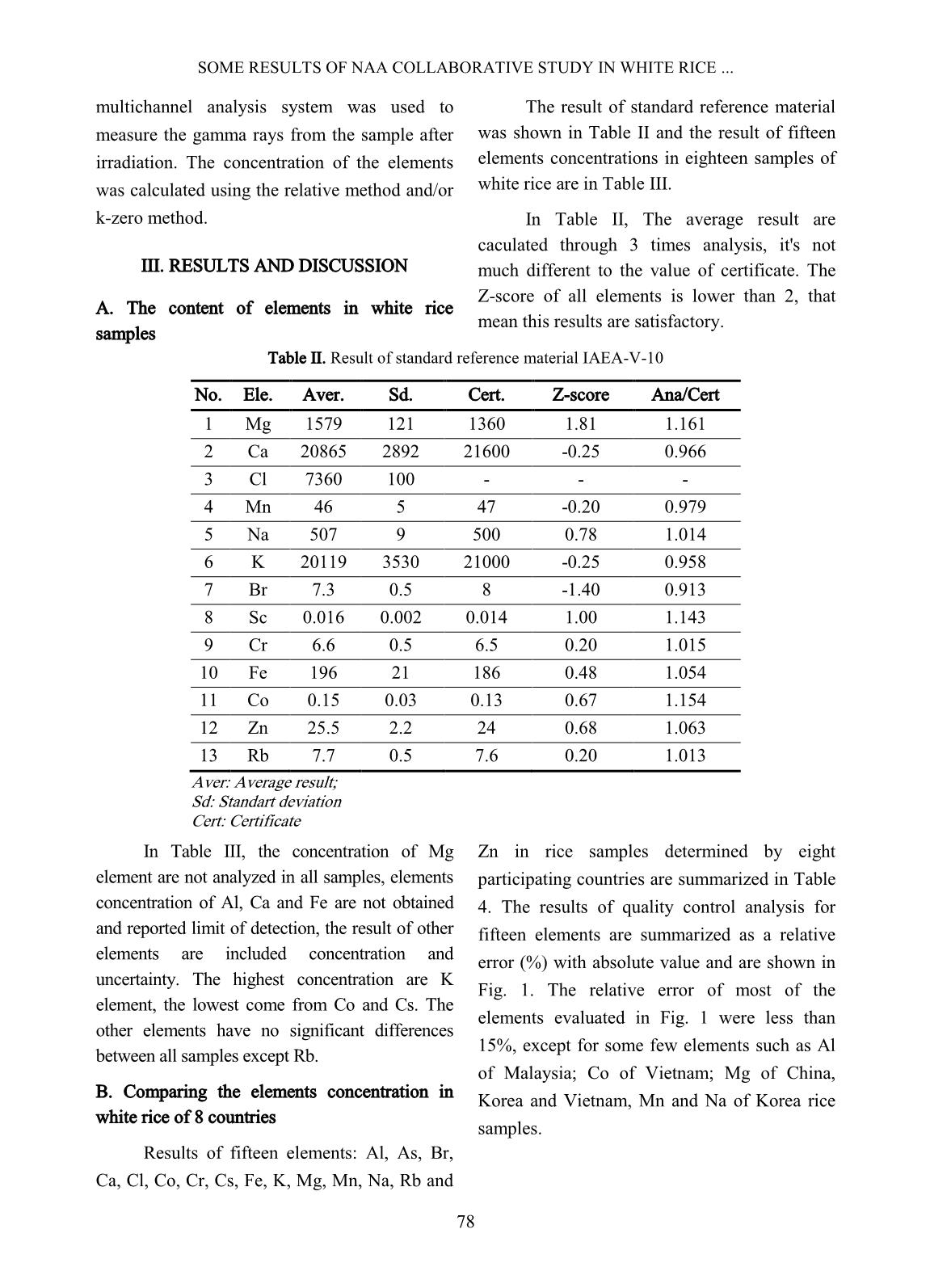
Trang 3
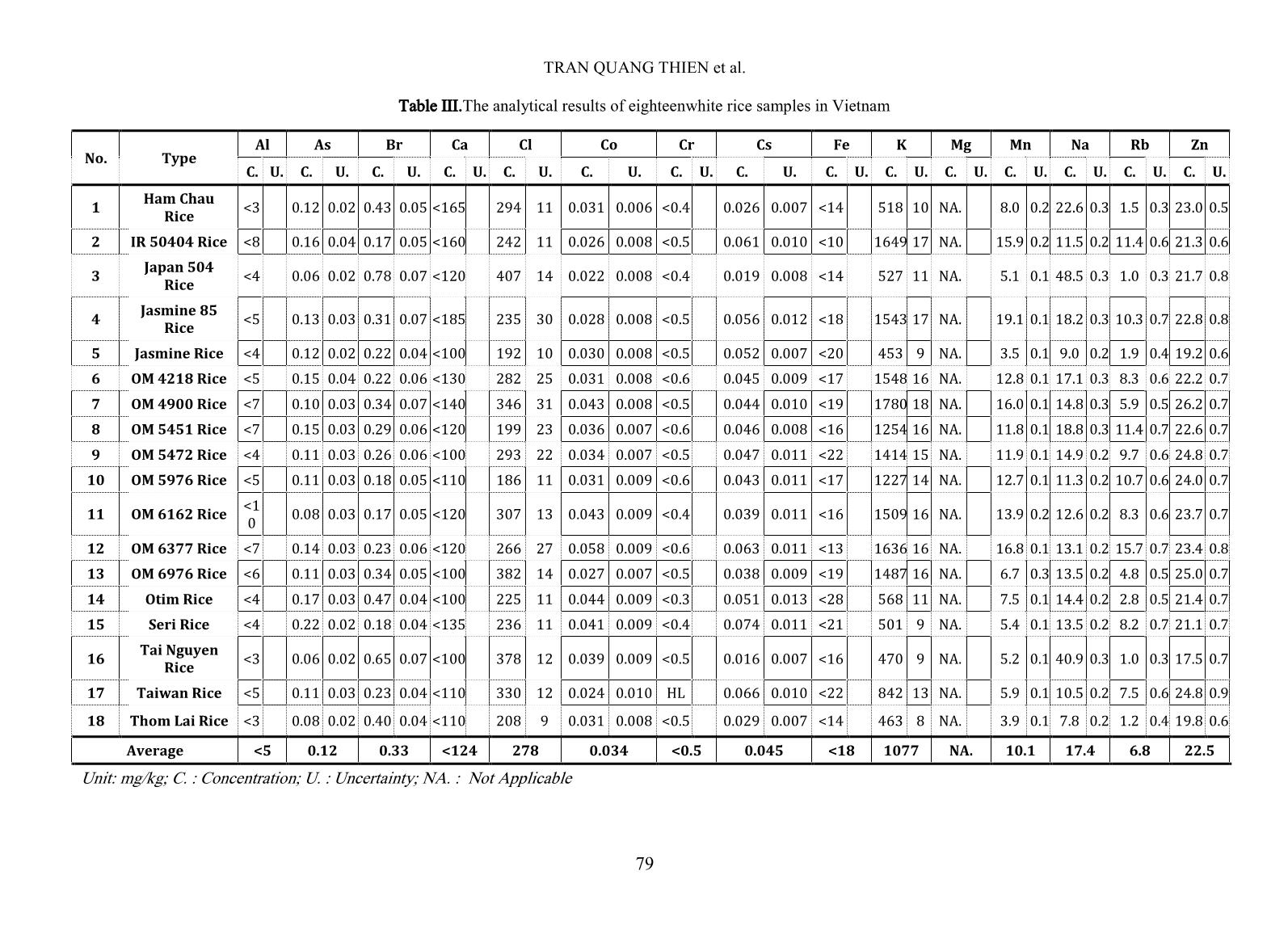
Trang 4
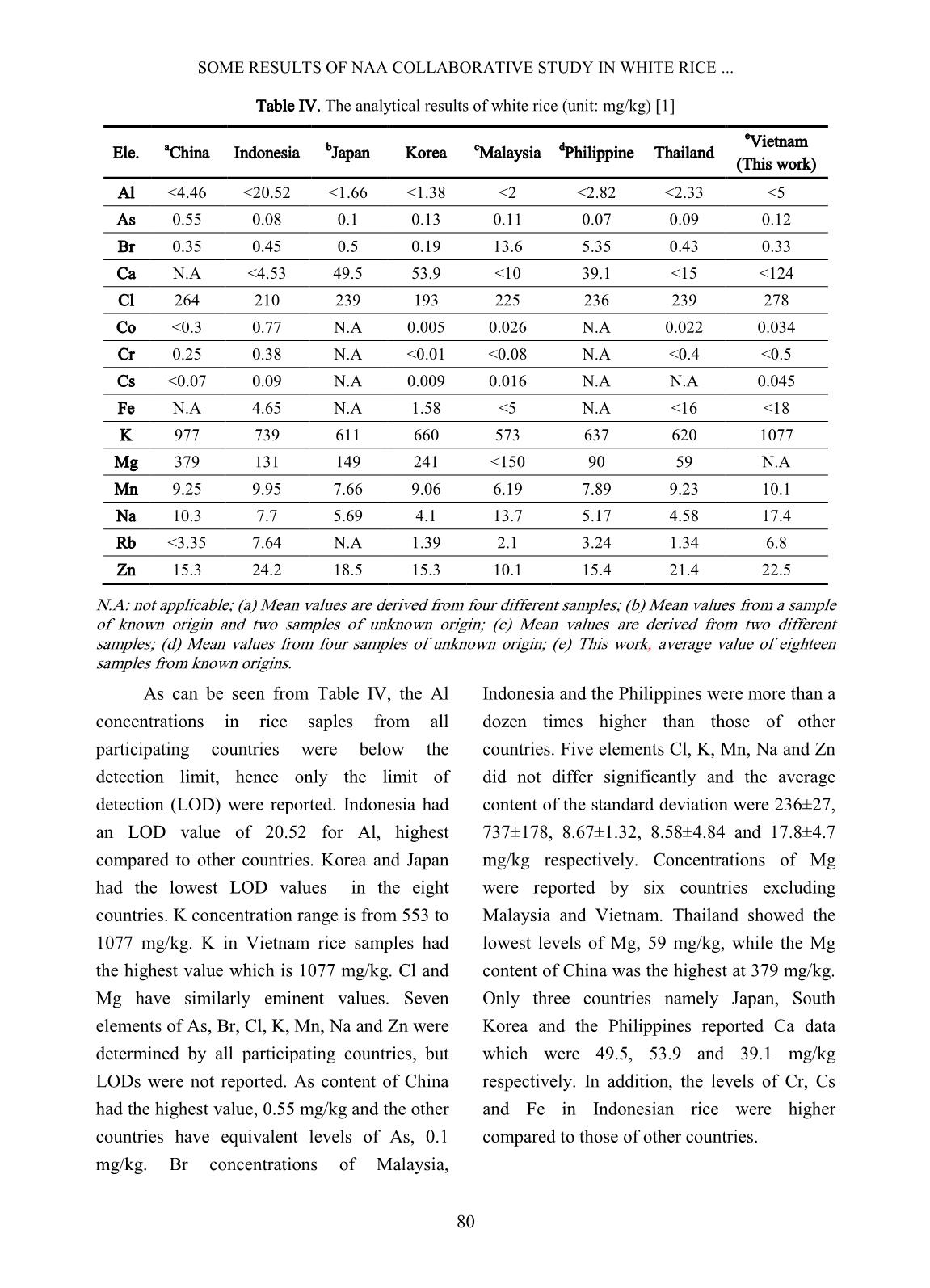
Trang 5
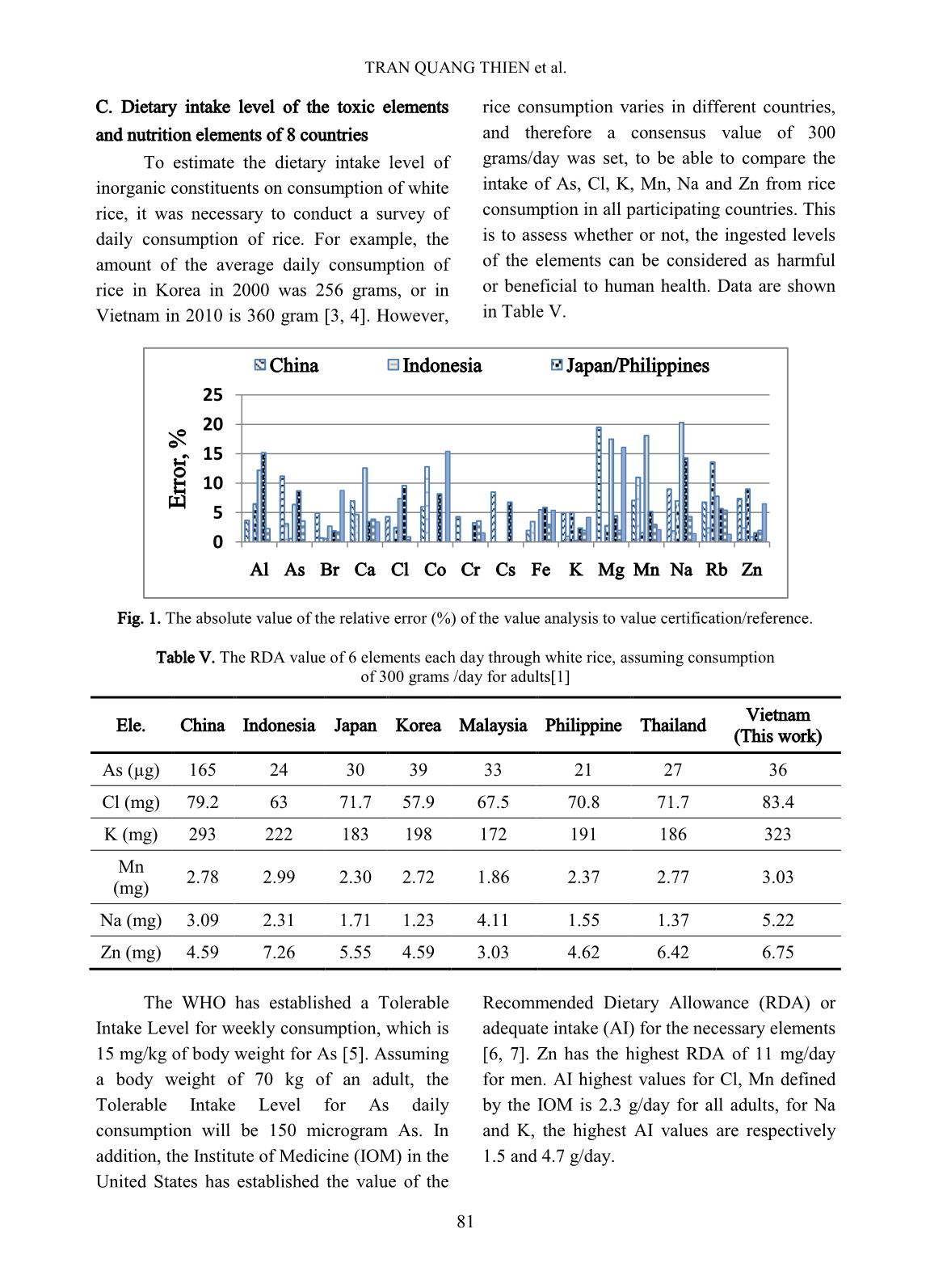
Trang 6
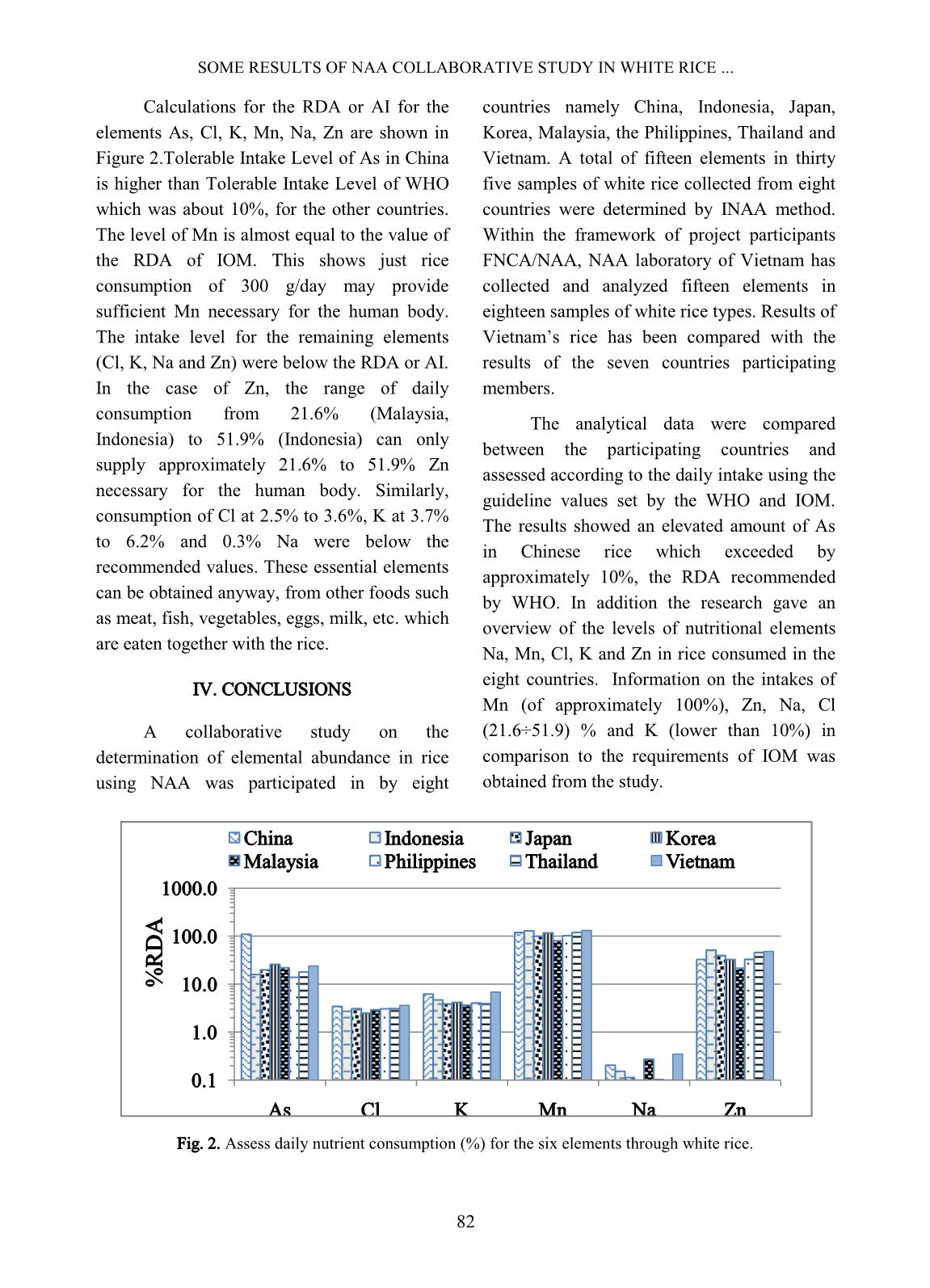
Trang 7
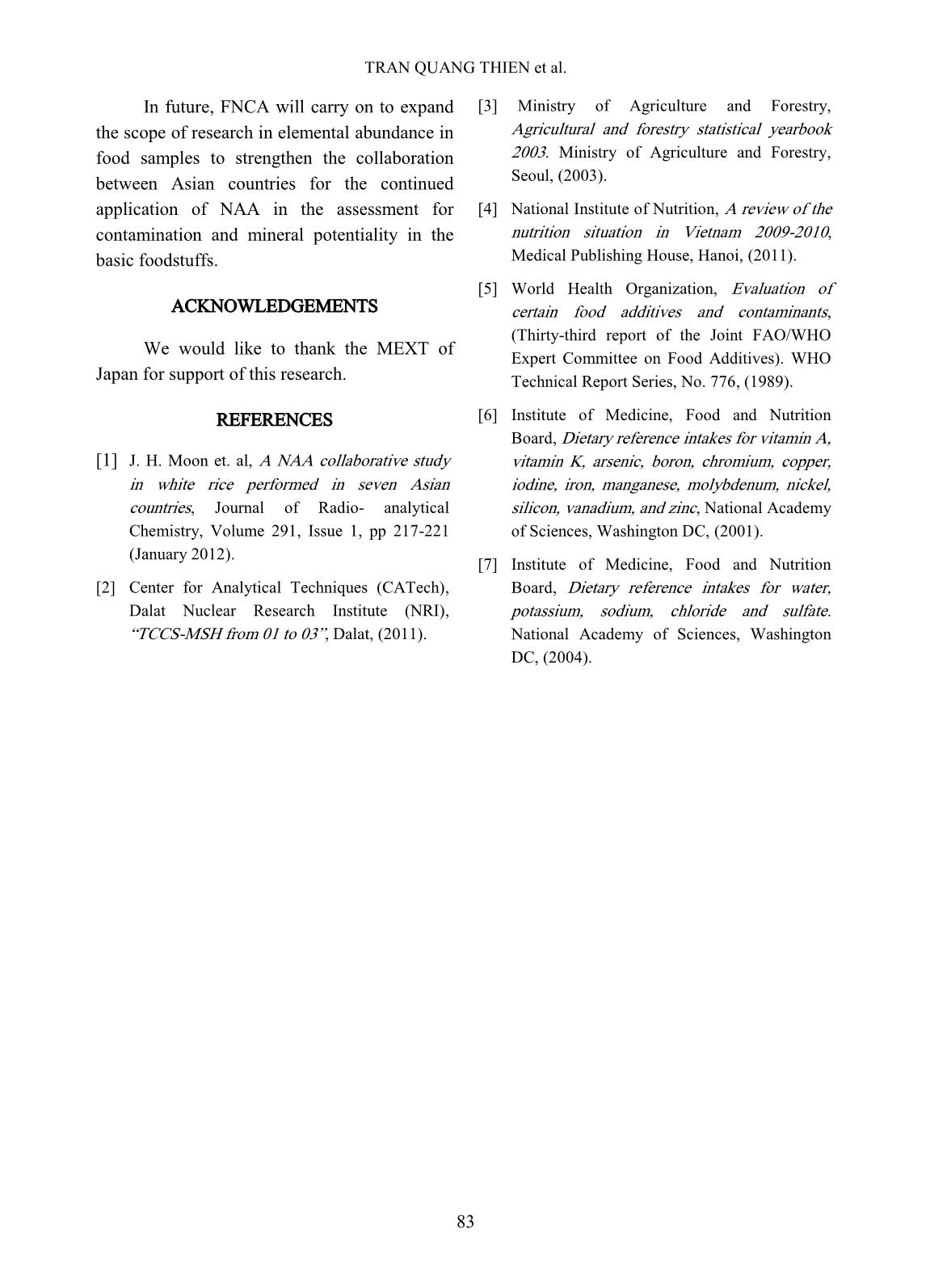
Trang 8
Tóm tắt nội dung tài liệu: Some results of NAA collaborative study in white rice performed at Dalat nuclear research institute
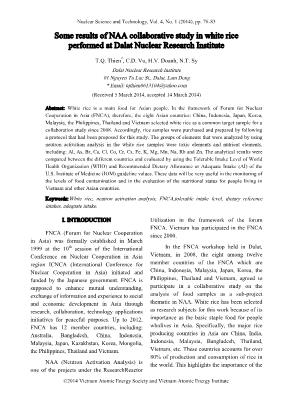
tions. The HPGe detector with SOME RESULTS OF NAA COLLABORATIVE STUDY IN WHITE RICE ... 78 multichannel analysis system was used to measure the gamma rays from the sample after irradiation. The concentration of the elements was calculated using the relative method and/or k-zero method. III. RESULTS AND DISCUSSION A. The content of elements in white rice samples The result of standard reference material was shown in Table II and the result of fifteen elements concentrations in eighteen samples of white rice are in Table III. In Table II, The average result are caculated through 3 times analysis, it's not much different to the value of certificate. The Z-score of all elements is lower than 2, that mean this results are satisfactory. Table II. Result of standard reference material IAEA-V-10 No. Ele. Aver. Sd. Cert. Z-score Ana/Cert 1 Mg 1579 121 1360 1.81 1.161 2 Ca 20865 2892 21600 -0.25 0.966 3 Cl 7360 100 - - - 4 Mn 46 5 47 -0.20 0.979 5 Na 507 9 500 0.78 1.014 6 K 20119 3530 21000 -0.25 0.958 7 Br 7.3 0.5 8 -1.40 0.913 8 Sc 0.016 0.002 0.014 1.00 1.143 9 Cr 6.6 0.5 6.5 0.20 1.015 10 Fe 196 21 186 0.48 1.054 11 Co 0.15 0.03 0.13 0.67 1.154 12 Zn 25.5 2.2 24 0.68 1.063 13 Rb 7.7 0.5 7.6 0.20 1.013 Aver: Average result; Sd: Standart deviation Cert: Certificate In Table III, the concentration of Mg element are not analyzed in all samples, elements concentration of Al, Ca and Fe are not obtained and reported limit of detection, the result of other elements are included concentration and uncertainty. The highest concentration are K element, the lowest come from Co and Cs. The other elements have no significant differences between all samples except Rb. B. Comparing the elements concentration in white rice of 8 countries Results of fifteen elements: Al, As, Br, Ca, Cl, Co, Cr, Cs, Fe, K, Mg, Mn, Na, Rb and Zn in rice samples determined by eight participating countries are summarized in Table 4. The results of quality control analysis for fifteen elements are summarized as a relative error (%) with absolute value and are shown in Fig. 1. The relative error of most of the elements evaluated in Fig. 1 were less than 15%, except for some few elements such as Al of Malaysia; Co of Vietnam; Mg of China, Korea and Vietnam, Mn and Na of Korea rice samples. TRAN QUANG THIEN et al. 79 Table III.The analytical results of eighteenwhite rice samples in Vietnam No. Type Al As Br Ca Cl Co Cr Cs Fe K Mg Mn Na Rb Zn C. U. C. U. C. U. C. U. C. U. C. U. C. U. C. U. C. U. C. U. C. U. C. U. C. U. C. U. C. U. 1 Ham Chau Rice <3 0.12 0.02 0.43 0.05 <165 294 11 0.031 0.006 <0.4 0.026 0.007 <14 518 10 NA. 8.0 0.2 22.6 0.3 1.5 0.3 23.0 0.5 2 IR 50404 Rice <8 0.16 0.04 0.17 0.05 <160 242 11 0.026 0.008 <0.5 0.061 0.010 <10 1649 17 NA. 15.9 0.2 11.5 0.2 11.4 0.6 21.3 0.6 3 Japan 504 Rice <4 0.06 0.02 0.78 0.07 <120 407 14 0.022 0.008 <0.4 0.019 0.008 <14 527 11 NA. 5.1 0.1 48.5 0.3 1.0 0.3 21.7 0.8 4 Jasmine 85 Rice <5 0.13 0.03 0.31 0.07 <185 235 30 0.028 0.008 <0.5 0.056 0.012 <18 1543 17 NA. 19.1 0.1 18.2 0.3 10.3 0.7 22.8 0.8 5 Jasmine Rice <4 0.12 0.02 0.22 0.04 <100 192 10 0.030 0.008 <0.5 0.052 0.007 <20 453 9 NA. 3.5 0.1 9.0 0.2 1.9 0.4 19.2 0.6 6 OM 4218 Rice <5 0.15 0.04 0.22 0.06 <130 282 25 0.031 0.008 <0.6 0.045 0.009 <17 1548 16 NA. 12.8 0.1 17.1 0.3 8.3 0.6 22.2 0.7 7 OM 4900 Rice <7 0.10 0.03 0.34 0.07 <140 346 31 0.043 0.008 <0.5 0.044 0.010 <19 1780 18 NA. 16.0 0.1 14.8 0.3 5.9 0.5 26.2 0.7 8 OM 5451 Rice <7 0.15 0.03 0.29 0.06 <120 199 23 0.036 0.007 <0.6 0.046 0.008 <16 1254 16 NA. 11.8 0.1 18.8 0.3 11.4 0.7 22.6 0.7 9 OM 5472 Rice <4 0.11 0.03 0.26 0.06 <100 293 22 0.034 0.007 <0.5 0.047 0.011 <22 1414 15 NA. 11.9 0.1 14.9 0.2 9.7 0.6 24.8 0.7 10 OM 5976 Rice <5 0.11 0.03 0.18 0.05 <110 186 11 0.031 0.009 <0.6 0.043 0.011 <17 1227 14 NA. 12.7 0.1 11.3 0.2 10.7 0.6 24.0 0.7 11 OM 6162 Rice <1 0 0.08 0.03 0.17 0.05 <120 307 13 0.043 0.009 <0.4 0.039 0.011 <16 1509 16 NA. 13.9 0.2 12.6 0.2 8.3 0.6 23.7 0.7 12 OM 6377 Rice <7 0.14 0.03 0.23 0.06 <120 266 27 0.058 0.009 <0.6 0.063 0.011 <13 1636 16 NA. 16.8 0.1 13.1 0.2 15.7 0.7 23.4 0.8 13 OM 6976 Rice <6 0.11 0.03 0.34 0.05 <100 382 14 0.027 0.007 <0.5 0.038 0.009 <19 1487 16 NA. 6.7 0.3 13.5 0.2 4.8 0.5 25.0 0.7 14 Otim Rice <4 0.17 0.03 0.47 0.04 <100 225 11 0.044 0.009 <0.3 0.051 0.013 <28 568 11 NA. 7.5 0.1 14.4 0.2 2.8 0.5 21.4 0.7 15 Seri Rice <4 0.22 0.02 0.18 0.04 <135 236 11 0.041 0.009 <0.4 0.074 0.011 <21 501 9 NA. 5.4 0.1 13.5 0.2 8.2 0.7 21.1 0.7 16 Tai Nguyen Rice <3 0.06 0.02 0.65 0.07 <100 378 12 0.039 0.009 <0.5 0.016 0.007 <16 470 9 NA. 5.2 0.1 40.9 0.3 1.0 0.3 17.5 0.7 17 Taiwan Rice <5 0.11 0.03 0.23 0.04 <110 330 12 0.024 0.010 HL 0.066 0.010 <22 842 13 NA. 5.9 0.1 10.5 0.2 7.5 0.6 24.8 0.9 18 Thom Lai Rice <3 0.08 0.02 0.40 0.04 <110 208 9 0.031 0.008 <0.5 0.029 0.007 <14 463 8 NA. 3.9 0.1 7.8 0.2 1.2 0.4 19.8 0.6 Average <5 0.12 0.33 <124 278 0.034 <0.5 0.045 <18 1077 NA. 10.1 17.4 6.8 22.5 Unit: mg/kg; C. : Concentration; U. : Uncertainty; NA. : Not Applicable SOME RESULTS OF NAA COLLABORATIVE STUDY IN WHITE RICE ... 80 Table IV. The analytical results of white rice (unit: mg/kg) [1] Ele. a China Indonesia b Japan Korea c Malaysia d Philippine Thailand e Vietnam (This work) Al <4.46 <20.52 <1.66 <1.38 <2 <2.82 <2.33 <5 As 0.55 0.08 0.1 0.13 0.11 0.07 0.09 0.12 Br 0.35 0.45 0.5 0.19 13.6 5.35 0.43 0.33 Ca N.A <4.53 49.5 53.9 <10 39.1 <15 <124 Cl 264 210 239 193 225 236 239 278 Co <0.3 0.77 N.A 0.005 0.026 N.A 0.022 0.034 Cr 0.25 0.38 N.A <0.01 <0.08 N.A <0.4 <0.5 Cs <0.07 0.09 N.A 0.009 0.016 N.A N.A 0.045 Fe N.A 4.65 N.A 1.58 <5 N.A <16 <18 K 977 739 611 660 573 637 620 1077 Mg 379 131 149 241 <150 90 59 N.A Mn 9.25 9.95 7.66 9.06 6.19 7.89 9.23 10.1 Na 10.3 7.7 5.69 4.1 13.7 5.17 4.58 17.4 Rb <3.35 7.64 N.A 1.39 2.1 3.24 1.34 6.8 Zn 15.3 24.2 18.5 15.3 10.1 15.4 21.4 22.5 N.A: not applicable; (a) Mean values are derived from four different samples; (b) Mean values from a sample of known origin and two samples of unknown origin; (c) Mean values are derived from two different samples; (d) Mean values from four samples of unknown origin; (e) This work, average value of eighteen samples from known origins. As can be seen from Table IV, the Al concentrations in rice saples from all participating countries were below the detection limit, hence only the limit of detection (LOD) were reported. Indonesia had an LOD value of 20.52 for Al, highest compared to other countries. Korea and Japan had the lowest LOD values in the eight countries. K concentration range is from 553 to 1077 mg/kg. K in Vietnam rice samples had the highest value which is 1077 mg/kg. Cl and Mg have similarly eminent values. Seven elements of As, Br, Cl, K, Mn, Na and Zn were determined by all participating countries, but LODs were not reported. As content of China had the highest value, 0.55 mg/kg and the other countries have equivalent levels of As, 0.1 mg/kg. Br concentrations of Malaysia, Indonesia and the Philippines were more than a dozen times higher than those of other countries. Five elements Cl, K, Mn, Na and Zn did not differ significantly and the average content of the standard deviation were 236±27, 737±178, 8.67±1.32, 8.58±4.84 and 17.8±4.7 mg/kg respectively. Concentrations of Mg were reported by six countries excluding Malaysia and Vietnam. Thailand showed the lowest levels of Mg, 59 mg/kg, while the Mg content of China was the highest at 379 mg/kg. Only three countries namely Japan, South Korea and the Philippines reported Ca data which were 49.5, 53.9 and 39.1 mg/kg respectively. In addition, the levels of Cr, Cs and Fe in Indonesian rice were higher compared to those of other countries. TRAN QUANG THIEN et al. 81 C. Dietary intake level of the toxic elements and nutrition elements of 8 countries To estimate the dietary intake level of inorganic constituents on consumption of white rice, it was necessary to conduct a survey of daily consumption of rice. For example, the amount of the average daily consumption of rice in Korea in 2000 was 256 grams, or in Vietnam in 2010 is 360 gram [3, 4]. However, rice consumption varies in different countries, and therefore a consensus value of 300 grams/day was set, to be able to compare the intake of As, Cl, K, Mn, Na and Zn from rice consumption in all participating countries. This is to assess whether or not, the ingested levels of the elements can be considered as harmful or beneficial to human health. Data are shown in Table V. Fig. 1. The absolute value of the relative error (%) of the value analysis to value certification/reference. Table V. The RDA value of 6 elements each day through white rice, assuming consumption of 300 grams /day for adults[1] Ele. China Indonesia Japan Korea Malaysia Philippine Thailand Vietnam (This work) As (µg) 165 24 30 39 33 21 27 36 Cl (mg) 79.2 63 71.7 57.9 67.5 70.8 71.7 83.4 K (mg) 293 222 183 198 172 191 186 323 Mn (mg) 2.78 2.99 2.30 2.72 1.86 2.37 2.77 3.03 Na (mg) 3.09 2.31 1.71 1.23 4.11 1.55 1.37 5.22 Zn (mg) 4.59 7.26 5.55 4.59 3.03 4.62 6.42 6.75 The WHO has established a Tolerable Intake Level for weekly consumption, which is 15 mg/kg of body weight for As [5]. Assuming a body weight of 70 kg of an adult, the Tolerable Intake Level for As daily consumption will be 150 microgram As. In addition, the Institute of Medicine (IOM) in the United States has established the value of the Recommended Dietary Allowance (RDA) or adequate intake (AI) for the necessary elements [6, 7]. Zn has the highest RDA of 11 mg/day for men. AI highest values for Cl, Mn defined by the IOM is 2.3 g/day for all adults, for Na and K, the highest AI values are respectively 1.5 and 4.7 g/day. 0 5 10 15 20 25 Al As Br Ca Cl Co Cr Cs Fe K Mg Mn Na Rb Zn E rr o r, % China Indonesia Japan/Philippines SOME RESULTS OF NAA COLLABORATIVE STUDY IN WHITE RICE ... 82 Calculations for the RDA or AI for the elements As, Cl, K, Mn, Na, Zn are shown in Figure 2.Tolerable Intake Level of As in China is higher than Tolerable Intake Level of WHO which was about 10%, for the other countries. The level of Mn is almost equal to the value of the RDA of IOM. This shows just rice consumption of 300 g/day may provide sufficient Mn necessary for the human body. The intake level for the remaining elements (Cl, K, Na and Zn) were below the RDA or AI. In the case of Zn, the range of daily consumption from 21.6% (Malaysia, Indonesia) to 51.9% (Indonesia) can only supply approximately 21.6% to 51.9% Zn necessary for the human body. Similarly, consumption of Cl at 2.5% to 3.6%, K at 3.7% to 6.2% and 0.3% Na were below the recommended values. These essential elements can be obtained anyway, from other foods such as meat, fish, vegetables, eggs, milk, etc. which are eaten together with the rice. IV. CONCLUSIONS A collaborative study on the determination of elemental abundance in rice using NAA was participated in by eight countries namely China, Indonesia, Japan, Korea, Malaysia, the Philippines, Thailand and Vietnam. A total of fifteen elements in thirty five samples of white rice collected from eight countries were determined by INAA method. Within the framework of project participants FNCA/NAA, NAA laboratory of Vietnam has collected and analyzed fifteen elements in eighteen samples of white rice types. Results of Vietnam’s rice has been compared with the results of the seven countries participating members. The analytical data were compared between the participating countries and assessed according to the daily intake using the guideline values set by the WHO and IOM. The results showed an elevated amount of As in Chinese rice which exceeded by approximately 10%, the RDA recommended by WHO. In addition the research gave an overview of the levels of nutritional elements Na, Mn, Cl, K and Zn in rice consumed in the eight countries. Information on the intakes of Mn (of approximately 100%), Zn, Na, Cl (21.6÷51.9) % and K (lower than 10%) in comparison to the requirements of IOM was obtained from the study. Fig. 2. Assess daily nutrient consumption (%) for the six elements through white rice. 0.1 1.0 10.0 100.0 1000.0 As Cl K Mn Na Zn % R D A China Indonesia Japan Korea Malaysia Philippines Thailand Vietnam TRAN QUANG THIEN et al. 83 In future, FNCA will carry on to expand the scope of research in elemental abundance in food samples to strengthen the collaboration between Asian countries for the continued application of NAA in the assessment for contamination and mineral potentiality in the basic foodstuffs. ACKNOWLEDGEMENTS We would like to thank the MEXT of Japan for support of this research. REFERENCES [1] J. H. Moon et. al, A NAA collaborative study in white rice performed in seven Asian countries, Journal of Radio- analytical Chemistry, Volume 291, Issue 1, pp 217-221 (January 2012). [2] Center for Analytical Techniques (CATech), Dalat Nuclear Research Institute (NRI), “TCCS-MSH from 01 to 03”, Dalat, (2011). [3] Ministry of Agriculture and Forestry, Agricultural and forestry statistical yearbook 2003. Ministry of Agriculture and Forestry, Seoul, (2003). [4] National Institute of Nutrition, A review of the nutrition situation in Vietnam 2009-2010, Medical Publishing House, Hanoi, (2011). [5] World Health Organization, Evaluation of certain food additives and contaminants, (Thirty-third report of the Joint FAO/WHO Expert Committee on Food Additives). WHO Technical Report Series, No. 776, (1989). [6] Institute of Medicine, Food and Nutrition Board, Dietary reference intakes for vitamin A, vitamin K, arsenic, boron, chromium, copper, iodine, iron, manganese, molybdenum, nickel, silicon, vanadium, and zinc, National Academy of Sciences, Washington DC, (2001). [7] Institute of Medicine, Food and Nutrition Board, Dietary reference intakes for water, potassium, sodium, chloride and sulfate. National Academy of Sciences, Washington DC, (2004).
File đính kèm:
 some_results_of_naa_collaborative_study_in_white_rice_perfor.pdf
some_results_of_naa_collaborative_study_in_white_rice_perfor.pdf

